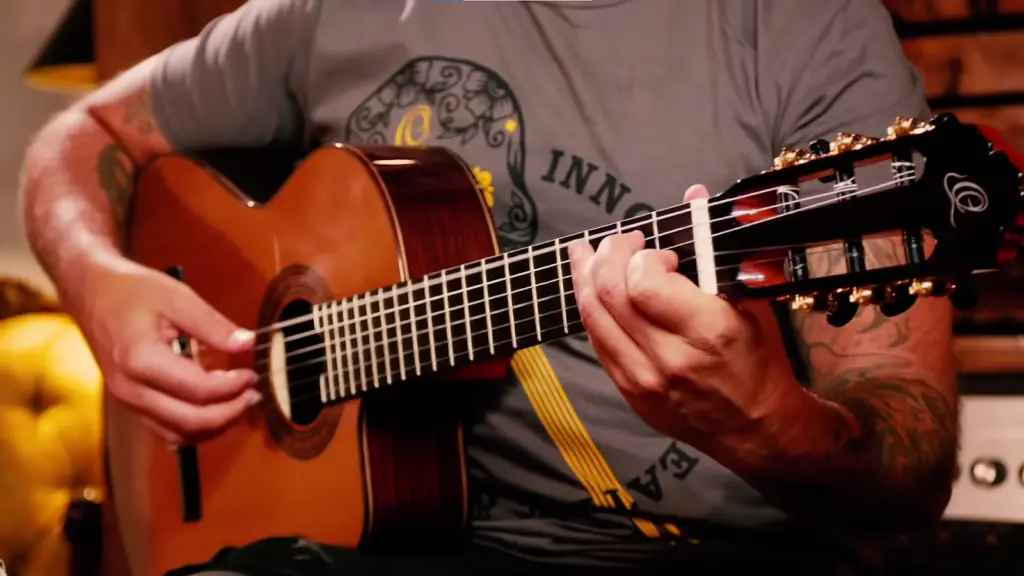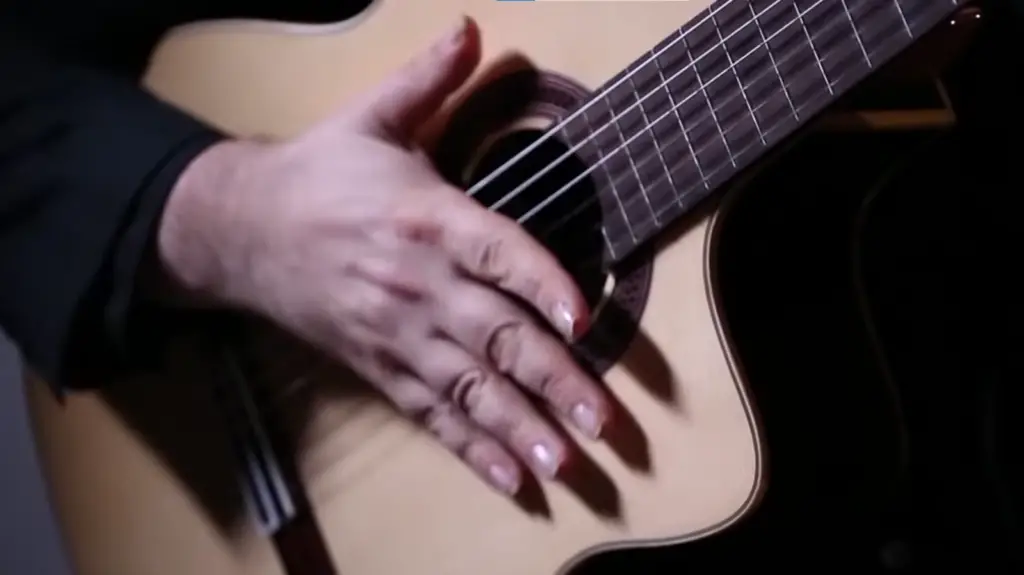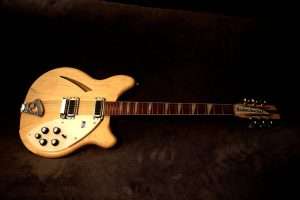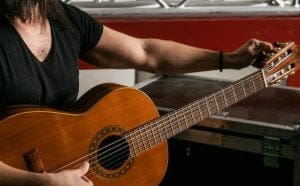Table of Contents
Know The Differences: Flamenco Vs Classical Guitar
Have you ever found yourself staring at a guitar, wondering whether it’s classical or flamenco?
While they share certain similarities—such as the nylon-string and basic shape— the main differences between classical and flamenco guitars are in construction, sound quality, and playing technique.
So, why should you care about the differences between a classical guitar and a flamenco guitar? Because understanding the nuances can drastically affect your playing style, influence your musical choices, and simply make you a more well-rounded musician.

Classical Guitars
Origins
The classical guitar finds its roots in the late 18th and early 19th centuries. Born from a family of stringed instruments like the lute, the classical guitar was refined over time to suit the intricate compositions of classical music. It gained prominence in European salons and concert halls, where virtuoso performers like Andrés Segovia showcased its artistic potential.
Evolution
Over the years, luthiers and musicians alike worked together to improve the instrument’s design, optimizing it for sustain and resonance. The result is the modern classical guitar, capable of capturing a wide range of musical expressions, from the subtlety of a Bach fugue to the robustness of a Spanish dance.
Flamenco Guitar
Roots
Unlike its classical counterpart, the flamenco guitar has a different tale to tell, it has its roots in Spain. Originating in Andalusia, it became an integral part of flamenco music, a genre that blends singing, guitar playing, and flamenco dance, often with percussive handclaps and intricate footwork.
Evolution and Specialization
Flamenco guitars evolved to meet the demands of this lively, passionate music. Designed for responsiveness and volume, they needed to hold their own against the powerful foot stomps and claps of flamenco dancers and the fervent vocals of the singers.
Over time, specialized features were incorporated, such as a tap plate to protect against aggressive strumming, making it a unique instrument tailored for the flamenco style.
Find Classical guitars on Amazon.
What Physical Features Set These Apart: Flamenco Vs Classical Guitars?
Wood Type
Classical Guitars
Classical guitars predominantly use cedar or spruce for their soundboards. Cedar tends to produce a warm, rich tone and is more forgiving to unseasoned players. Spruce, on the other hand, delivers a brighter, more dynamic range but may require a more experienced touch to bring out its full potential.

Flamenco Guitars
The back and sides are often made of cypress or spruce in a flamenco guitar. Cypress is lighter and less dense, contributing to the guitar’s brighter, “snappier” sound—a hallmark of flamenco music. Some modern flamenco guitars also use spruce for similar reasons but generally aim for a brighter, more percussive sound than classical guitars. Some are called Flamenco Negra which has denser wood. Great for playing techniques like Golpeador.
Body Depth
Classical Guitars
These guitars usually have a deeper body, measuring around 4 to 4.5 inches. The additional depth contributes to a more resonant and fuller sound, well-suited for intricate classical compositions that require sustained notes and a wide tonal range.
Flamenco Guitars
Flamenco guitar is thinner in contrast to a classical guitar body, generally around 3.5 to 4 inches deep. This design choice aims to produce a brighter, more immediate sound that cuts through the ambient noise during flamenco performances.
Scale Length and Fretboard
Classical Guitars
Classical guitars usually feature a longer scale length, around 650 to 655 mm, which provides more space between the frets. This makes it easier to play complex fingerstyle techniques but might be less comfortable for smaller hands. The fretboard is commonly made of ebony, designed for durability and a smooth playing experience. The guitars are designed in such a way that the higher action allows you to play any style on it.

Flamenco Guitars
Flamenco guitars have a similar scale length but often feature a lower action and slightly different neck angle. This makes for a quicker response time, vital for the fast-paced strumming and fingerpicking while you play flamenco music. While ebony is also used, some flamenco guitars opt for rosewoods to achieve a different texture and feel. It can be either Indian rosewood or Brazilian rosewood.
How Do Flamenco and Classical Guitars Differ in Sound?
Classical Guitars
Fullness and Warmth
One of the defining characteristics of classical guitars is their full, warm sound. This is achieved through a combination of factors like deeper body depth and the type of wood used for the soundboard. This allows the classical guitar to excel in rendering intricate melodies and complex harmonies—perfect for compositions that span a broad tonal spectrum.
Versatility
It’s worth noting that the classical guitar isn’t limited to classical music. Its versatile sound profile allows it to be a choice instrument for other genres like jazz, folk, and Latin music.
Listen To The Sound of Classical Guitars
Flamenco Guitars
Brightness and Attack
Flamenco guitars produce a brighter, crisper sound that packs a lot of attack with the hint of a buzz. This is crucial for cutting through the accompanying flamenco handclaps, foot stomps, and powerful vocals typical in flamenco performances.
Percussive Qualities
Beyond just being bright, flamenco guitars have a percussive character. They’re designed to accentuate rhythmic strumming patterns and rapid fingerpicking techniques. The guitar is not just a melodic instrument in flamenco—it’s also a rhythm instrument.
Listen To The Sound of Flamenco Guitars
Playability
String Tension and Action
Classical Guitars
Classical guitars usually feature higher string tension, providing a fuller tone but requiring more finger pressure to fret the notes. The action—defined as the distance between the strings and the fretboard—is generally higher, facilitating a greater tonal range and dynamic expression but potentially making fast passages more challenging.
Flamenco Guitars
The low string height on flamenco guitars makes it easier to perform quick runs and strumming patterns. The height of the strings is typically lower, too, which allows for easier and faster fretting. This is crucial for flamenco music, where rapid finger movements are often needed.
Enhance your playability with these classical guitar accessories.
Responsiveness
Flamenco guitars are generally more responsive, meaning they react quickly to your touch. This allows for explosive playing techniques, like rasgueados (a strumming technique), to shine through. Classical guitars, while responsive, are usually more forgiving, letting you shape the notes more substantially for expressive purposes.
What Musical Genres Are Best Suited for Flamenco and Classical Guitars?
Classical Guitars
Classical and Beyond
While the name suggests its primary function in classical music, the classical guitar is incredibly versatile. It’s often used in jazz ensembles, Latin American folk music, and even some contemporary genres like indie or soft rock.
Its wide tonal range and capacity for subtle musical expression make it a favorite for intricate solo pieces and ensemble settings alike.
Emotional Depth
Due to its rich sound and diverse tonal capabilities, the classical guitar is excellent for pieces that require emotional depth and complexity, making it a staple in performance halls and academic settings.
Flamenco Guitars
The Soul of Flamenco
When you think of flamenco music—bursting with vocal improvisations, intricate handclaps, and complex dance routines—the flamenco guitar is the backbone. It provides both melody and rhythm, elevating the art form’s impassioned storytelling.
Fusion and Modern Interpretations
In recent years, the flamenco guitar has also been embraced in genres beyond traditional flamenco, including Flamenco Nuevo and even some forms of jazz and world music. Its bright, punchy sound lends itself to innovative musical experimentations.
Buyer’s Guide
Know Your Style
Your preferred genre should significantly influence your choice. If you’re a beginner who’s not yet sure, remember: classical guitars offer more versatility but require a bit more finger strength, while flamenco guitars are more specialized but easier to play fast.
Budget Considerations
Classical guitars tend to be more expensive due to the high-quality wood and construction methods used. Flamenco guitars can be more affordable but still vary in price depending on the brand and materials.
Try Before You Buy
If possible, always try to play the guitar or hear it played before making a purchase. Online reviews and recommendations can guide you, but there’s no substitute for experiencing the instrument’s feel and sound for yourself.
Find flamenco guitar on Amazon.
Which Brands Offer the Best Classical and Flamenco Guitars?
Alhambra
Price Range: $500 – $5,000
Why is Alhambra Special?
Alhambra is a Spanish brand known for producing classical guitars that offer a balanced combination of tradition and innovation. With a range that accommodates beginners to professionals, Alhambra guitars are handcrafted, often featuring cedar or spruce tops and quality rosewood or mahogany for the back and sides.
Cordoba Guitars
Price Range: $200 – $4,000
Why is Cordoba Special?
Cordoba is famous for blending traditional craftsmanship with modern elements. The brand’s classical guitars are known for their exceptional playability and warmth of tone. Popular among both students and touring musicians, Cordoba offers models that cater to a wide range of skill levels and budgets.
Yamaha Guitars
Price Range: $150 – $3,000
Why is Yamaha special?
Yamaha is a well-established Japanese brand that provides a variety of instruments, including classical guitars. Known for their durability and consistency, Yamaha’s classical guitars are a reliable choice for beginners and intermediate guitarists. They often feature spruce tops and nato or rosewood for the back and sides.
Check out an in-depth guide for the best classical guitars of 2023.
Best Brands for Flamenco Guitars
Conde Hermanos
Price Range: $3,000 – $10,000
Why is Conde Hermanos a Special?
As one of the most prestigious flamenco guitar makers, Conde Hermanos guitars have been used by flamenco legends like Paco de Lucía. Handmade in Spain, these guitars are known for their quick responsiveness and bright, snappy tone.
Ramirez
Price Range: $2,500 – $12,000
Why is Ramirez Special?
Ramirez is a heritage Spanish brand that crafts both classical and flamenco guitars. Their flamenco models are renowned for their rich tonal palette and exceptional playability, utilizing the finest woods like Spanish cypress and spruce.
Cordoba
Price Range: $200 – $4,000
Why is Cordoba Special?
Cordoba is unique in that it produces both classical and flamenco guitars, catering to a wide range of musical tastes and styles. This makes the brand a go-to choice for musicians who wish to explore multiple genres without investing in separate instruments for each.
It’s All About Preference
At the end of the day, the choice between a classical and flamenco guitar boils down to personal preference and the style of music you’re drawn to. Each offers a unique playing experience and serves a different musical purpose.
Beyond the Basics
As you’ve seen, the differences between these two types of guitars are nuanced, extending from their historical roots to their construction, sound qualities, playability, and role in various music genres.
Lifelong Musical Journey
Understanding these differences isn’t just a one-off task; it’s a step in your ongoing musical journey. Whether you’re an artist, an aficionado, or someone considering their first guitar purchase, recognizing what sets these guitars apart will deepen your appreciation for music and guide you toward making more informed choices.
Flamenco Vs Classical Guitar FAQs
No, a flamenco guitar is not the same as a classical guitar. While they share some similarities in appearance, they are designed for different styles of music and thus have distinct construction differences. Flamenco guitars are typically lighter, have a thinner top, and use different woods, such as cypress or sycamore, to produce a sharper, more percussive sound. Classical guitars, on the other hand, are built to offer a warmer, deeper tone, often using woods like rosewood or mahogany.
The difficulty of flamenco versus classical guitar can vary depending on the individual’s natural aptitude, dedication, and previous guitar experience. Flamenco guitar involves complex strumming patterns, aggressive finger techniques, and percussive effects that can be challenging for beginners. Classical guitar requires precise fingerpicking and a deep understanding of musical theory. Both styles demand dedication and practice, but the challenge is part of the joy of learning.
Yes, you can start learning flamenco on a classical guitar. Many of the fundamental techniques of flamenco can be practiced on a classical guitar. However, as you progress, you might find that a flamenco guitar’s setup—such as its lower action and specific body construction—facilitates flamenco techniques and produces the authentic sound you’re aiming for. Starting on a classical guitar can be a good stepping stone to understanding the basics before transitioning to a flamenco guitar.
Flamenco guitars often use lighter gauge strings compared to classical guitars, contributing to their distinctive sound and playability. The lighter strings on a flamenco guitar allow for a faster response and easier execution of flamenco techniques, such as rapid strumming and finger rolls. Classical guitars typically use heavier gauge nylon strings that produce a richer, more resonant tone suitable for classical music’s nuanced dynamics and sustained notes.
In flamenco music, the guitar is not just an accompanying instrument but a central piece that interacts dynamically with the dancers and singers. It provides rhythm, harmony, and even percussion through various techniques unique to flamenco. In classical music, the guitar often takes on a more solitary role, delivering complex compositions that showcase the instrument’s wide range of tones and textures. The guitar in classical music is celebrated for its ability to convey deep emotions and intricate musical narratives.
The choice between cedar, spruce, and negra (often referring to darker woods used in flamenco guitars, like rosewood) as the best tonewood depends on the sound and playing style you’re aiming for:
Cedar: Known for its warm, rich tones, cedar is responsive and produces a beautiful sound with less playing effort. It’s favored for classical and flamenco players seeking a mellow, full sound.
Spruce: Offers a brighter, more articulate sound with excellent clarity and projection. Spruce tops are versatile, catering to a wide range of playing styles, from classical to flamenco, and they tend to improve with age.
Negra (Rosewood): Provides deep, resonant basses and vibrant trebles, making it a popular choice for flamenco negra guitars. It’s ideal for players looking for volume, sustain, and a robust sound that can cut through in ensemble settings.
Look for a lightweight guitar with a low action, comfortable neck profile, and bright, responsive sound. Flamenco guitars typically have cypress or sycamore back and sides with a spruce or cedar top.
There are mainly two types: Flamenco Blanca, made from lighter woods like cypress, known for its bright, vibrant sound; and Flamenco Negra, made from darker woods like rosewood, offering deeper, richer tones.
The Golpeador is a protective plate or pickguard that is used to protect the top of the guitar from the aggressive tapping and percussive techniques used in flamenco playing called Golpe, preventing damage while allowing the guitarist to perform freely.
- Best 5 String Bass Guitars For Every Price Point - April 18, 2024
- Flamenco Vs Classical Guitar: A Guide to Key Similarities & Differences - March 7, 2024
- 11 Best Acoustic Bass Guitars – 2024 - March 7, 2024









